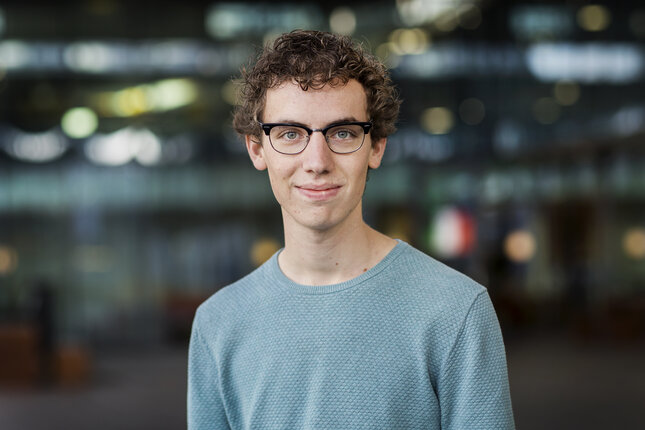Storing data in DNA capsules
Bas Bögels defended his PhD thesis at the Department of Biomedical Engineering on February 21st.

No longer storing data with ones and zeros, but with A, T, C and G - the building blocks of DNA. If TU/e researcher Bas Bögels and his colleagues have their way, we will soon be using DNA for long-term data storage. Bögels developed colored microcapsules – proteinosomes – to package DNA files individually and optimized the readout system so that stored data can be retrieved at very high accuracy.
Our society is digitizing rapidly. We stream and swipe all day long and we are becoming increasingly active on our socials. So it is no surprise that global data traffic has increased dramatically in recent years, in part due to video streaming, the Internet of Things, and AI applications.
And our increasing Internet traffic has a major environmental impact. Because all that fast streaming and swiping consumes an enormous amount of data, stored on servers in a data center. Running and cooling those servers requires a substantial amount of energy, which is already causing a greater CO2 emission worldwide than the entire aviation industry.
Memory of life
Over the past few years, TU/e researchers have been working hard on a new, sustainable method of storing data. This is also why PhD candidate Bas Bögels was present at the Dutch Design Week in October. With the help of an orange, a large fossil, and a piggy bank, he got to explain this new form of data storage to Queen Máxima.
“A symbolic representation of all the advantages at a glance,” says Bögels. “Data can be stored much more compactly. In theory, 1 gram of DNA can store 17 exabytes (1018 bytes, Ed.) of data; this means that a single orange could contain all the data traffic of a data center. And whereas a USB drive or hard drive only lasts a few years, DNA is super stable when stored cool and dry. It is still possible to read out DNA fragments in fossils dating back millions of years. This “memory of life” could potentially make data centers obsolete, saving on multiple fronts.”
“En waar een usb-stick of een harde schijf slechts enkele jaren meegaan, is DNA superstabiel als het koel en droog bewaard wordt. In fossielen van miljoenen jaren geleden kan je nog stukken DNA uitlezen. Dit ‘geheugen van het leven’ kan er voor zorgen dat datacentra mogelijk overbodig gaan worden, een besparing op meerdere fronten.”

Fluorescent barcode
It is unlikely that we will be storing our data in a literal test tube any time soon, Bögels explains. “Water and light pose great threats to the stability of DNA. Therefore, we started looking for a way to protect DNA from external influences.” As part of Professor Tom de Greef’s research group, Bögels worked together with Microsoft Research on manageable micro-particles.
Although he enjoys pushing his limits in his free time through his hobbies climbing and running, he also got the opportunity to take on quite a challenge in his doctoral research. And with great success. Bögels’ capsules consist of proteins and polymers that are attached to each other and can form small capsules through a soap-like process.
In his experiments, Bögels showed that you can attach all kinds of “sticky molecules” to the inside of these capsules. And that is very useful, he emphasizes.
“This way, we can bind small pieces of DNA, but also insert a magnetic particle, so that we can separate the capsules with a magnet. Or a fluorescent label, which can distinguish one capsule from another. This allows us to give every proteinosome – each containing a different file – its own barcode for easy retrieval.”
Error-free
The outer layer of the data capsule is sensitive to temperature, Bögels explains. And that made the data readout much more accurate, a bottleneck of the current error-prone method. “At room temperature, we can easily add molecules to the capsule, like a piece of DNA. At higher temperatures, the capsule becomes hydrophobic, creating an enclosed space.”
“A mini-lab where you can individually copy the respective piece of DNA in each capsule millions of times using a PCR reaction. We’ve found that this allows you to read out multiple files simultaneously, without the many errors that occur in the copying process when the DNA pieces are multiplied together.”
“To keep the stored DNA as far away from water as possible, the particles can be freeze-dried, extracting all the water from them. This ensures very stable storage, for thousands of years even, according to calculations.”
Faster cancer diagnosis
So for now, all eyes are focused on a new way of storing data. Thanks to the DNA capsules, this can now be realized quickly; Tom de Greef previously estimated that the first DNA data center could open within 5-10 years. In addition to storing data, the microcapsule can be used for a variety of purposes, Bögels emphasizes.
“We’ve looked at whether we can also use our platform as a diagnostic tool on a lab scale, for example, to detect certain biomarkers in the blood. That could speed up the identification of certain types of cancer. Now, we’re investigating whether we can also use the microcapsules to send controlled signals to cells.”
He intends to further explore this in a postdoc project at TU München. But first, his PhD ceremony. He has already received royal approval, Bögels winks, – recalling his special audience at the Dutch Design Week – all that remains now is his degree.
Title of Bas Bögels's dissertation: Exploring Compartmentalization for DNA Nanotechnology
Supervisors: Tom de Greef and Maarten Merkx
Latest news


![[Translate to English:] [Translate to English:]](https://assets.w3.tue.nl/w/fileadmin/_processed_/e/0/csm_BvOF%202019_1031_BHF%20license%20TUe%20ILI%20copy_8a50884392.jpg)